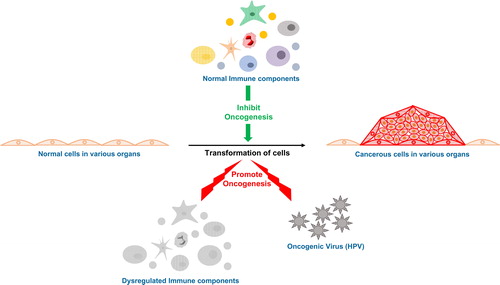A disease caused by uncontrolled cell division, known as cancer, is a complex multifactorial state involving multiple intrinsic and extrinsic factors in development. The host immune system plays a crucial role in the surveillance of cancer or tumor cells. Various cells in the immune system continuously scan for these modified cells and eliminate them. The host immune system broadly consists of two major systems, the innate and the adaptive immune system. Type I interferons and natural killer (NK) cells are components of the innate immune system that control cancerous cells through their antiproliferative and proapoptotic properties and through direct killing, respectively. Adaptive immune components such as subset of CD4+ (helper) and CD8+ (cytotoxic) T cells and type II interferons restrict the growth of cancerous cells. On another hand, the cancerous tissue and its microenvironment skews normal regulatory T (Treg) cells to become cancer-derived Treg cells, which has conspicuous suppressive effects on antitumor cytotoxic T cells. Furthermore, the suppressive effects are enhanced or maintained by the induction of various cytokines such as IL-10 and TGF-beta. All these responses make cancerous cells resistant to apoptosis and promote anticancer immune evasion and establish cancer development. This issue of International Reviews of Immunology focuses on extrinsic and intrinsic oncogenic and anticancer factors (Figure 1).
Cytokines or interleukins (ILs) are proteins produced by immune cells. These proteins mediate various immunological processes such as inflammation, recruitment and movement of immune cells, regulation of immune responses, and so on. IL-27 is one of the cytokines produced by antigen-presenting cells (dendritic cells and macrophages) and has pleotropic effects on innate and adaptive immunity. IL-27 acts on neutrophils, eosinophils, mast cells, and natural killer cells and involved in fighting during bacterial, viral and parasite infection. It also acts on specialized adaptive immune cells such as subsets of B and T cells. The first review article in this issue by Beizavi et al. discusses the biology of IL-27 and its influence during cancer through various immune cells [Citation1]. The article will be of interest to researchers working in oncology, immunology and translational oncoimmunology (Figure 1).
The human leukocyte antigen (HLA)-G plays an important role in immune tolerance and maternal-fetal tolerance during the gestation period and it is expressed on fetus-derived placental cells. HLA-G shows high similarity with the HLA I gene. This gene also expresses on different cancerous cells as a neocancer antigen, particularly in the advanced stages of various cancers, and promotes cancer cell survival and development of cancer through its immunosuppressive activity. It has been shown that HLA-G is a potential target for immunotherapy. The second review article in this issue by Marlatta et al. analyzes HLA-G in malignant melanomas and its prognostic potential in cancer [Citation2]. This article will be of value to cancer immunologists and researchers investigating immune tolerance (Figure 1).
Chemokines are small-size cytokine-like proteins secreted by different immune and nonimmune cells that mainly facilitate immune cell movement toward higher concentration through chemokine receptors. Various classes of chemokine are produced by cells, and they play an important role in various immunological processes such as inflammation and immune homeostasis. The expression and function of chemokines alter significantly in various infectious and noninfectious diseases. The third review article in this issue by Zangouei et al. discusses the role of chemokines in bladder cancer. The article describes the interaction between immune cells and bladder cancer tissues and discusses the role of an immune activator (Bacille Calmette-Guerin vaccine) in the treatment of bladder cancer. It also highlights the importance of chemokines and chemokine receptors as a marker for the early detection of this cancer, as well as for cancer progression and metastasis [Citation3]. This article will be of particular interest to oncoimmunologists and immunologists working on the fundamental and/or developmental aspects of cancer diagnostics (Figure 1).
Human papillomavirus (HPV) is a nonenveloped DNA virus that causes warts (small outgrowths over skin or mucous membrane) that may become cancerous. Several subtypes of this virus are associated with various cancer types such as head and neck cancer and cancers associated with the genital region. Approximately 70% of cervical cancers are associated with HPV and its incidence is mostly initiated through sexual intercourse between an infected and a healthy individual. In addition, it may also cause cancer of the vagina, vulva and penis. The last article in this issue by Jee et al. discusses the interaction between HPV and host immunity and the immune responses induced to control HPV infection. It also discusses the biology of HPV subunit vaccine and its role in protection against infection [Citation4]. This article will be of relevance to a broad readership in the fields of immunology, viral immunology, vaccine immunology and cancer immunology (Figure 1).
References
- IL-27, a pleiotropic cytokine for fine-tuning the immune response in cancer. Int Rev Immunol. 2021;40(5):319–329. doi:10.1080/08830185.202 1.1840565.
- HLA-G expression in melanomas. Int Rev Immunol. 2021;40(5):330–343. doi:10.1080/08830185.202 1.1869732
- Chemokines as the critical factors during bladder cancer progression: an overview. Int Rev Immunol. 2021;40(5):344–358. doi:10.1080/08830185.202 1.1877287
- Immunology of HPV-mediated cervical cancer: current understanding. Int Rev Immunol. 2021;40(5):359–378. doi:10.1080/08830185.202 1.1811859

